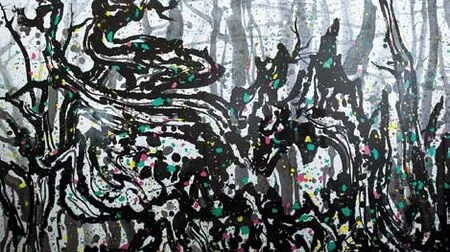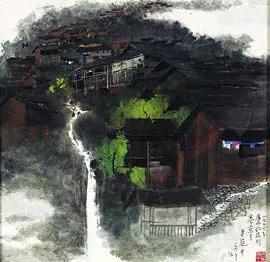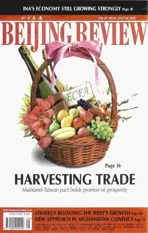A True Artistic Spirit
2010-09-12ByYINPUMIN
By YIN PUMIN
A True Artistic Spirit
By YIN PUMIN
The passing away of Wu Guanzhong, one of China’s forward-looking and admired artists, grieves the nation

PERSISTENT PURSUIT: Wu Guanzhong sketches in front of the Buckingham Palace when a solo exhibition for the artist was held in Britain
Wu Guanzhong, a master of Chinese painting of the 20th century, died in Beijing on June 25, 2010, aged 91.
Wu holds a special position in 20th century Chinese art, not only for his achievement in combining perfectly Chinese and Western styles, but also for his dedication to his form and generosity to the public. Although there was no grand mourning—according to the artist’s own wishes—people expressed their sorrow by holding exhibitions of Wu’s works, most generously donated by the master to public museums.
On July 1, paying tribute to the late artist, the Hong Kong Museum of Art launched an exhibition of the latest donation of Wu’s fve ink paintings. These works will also be included in an exhibition at the museum featuring a total of 52 precious works donated by Wu to the museum over the years. The exhibition will last from July 23 to August 29.
On July 7, a special exhibition was unveiled at the National Art Museum of China (NAMOC) to commemorate the contemporary art master. The exhibition, which will last until August 2, displays 62 of Wu’s works, 46 of which were donations from the painter.
The largest retrospective show of Wu’s works, which has been in preparation for months, will be staged at the Zhejiang Art Museum in November this year. It will feature at least 300 works on loan from several public museums.
A life in art
Wu was born on July 5, 1919, in Yixing, Jiangsu Province. At the age of 17, he enrolled at the National Arts Academy of Hangzhou in Zhejiang Province, studying both Chinese and Western painting under the guidance of painting masters Pan Tianshou (1897-1971) and Lin Fengmian (1900-1991).
In 1947, Wu traveled to Paris to further study art on a government scholarship, where he was greatly impressed by works of many Western painters, especially Vincent van Gogh.
Unlike some of his Chinese classmates, Wu returned to China to teach art at several universities and art schools, including the Central Academy of Fine Arts in Beijing, the Architectural Department of Tsinghua University and the Central Academy of Arts and Design, which is today’s School of Artsand Design of Tsinghua University.
His creation, teaching and research focused on the integration of Chinese and Western styles. “I love both traditional Chinese art and the bold expression of Western oil painting. I was inspired by both during my art career,” Wu once said.
In his opinion, the essence of art is the expression of human emotions. People speaking different languages can have the same feelings toward warmth and cold. “Chinese ink and wash and Western oil painting are just techniques which should be sublimated to the expression of emotions.”
Wu’s most precious quality lies in his lifelong exploration of artistic innovation in integrating Western painting skills and traditional Chinese art and culture, said Fan Di’an, Director of the NAMOC. “With a profound understanding of Western art, Wu also attached importance to traditional Chinese art and culture. This is especially hard to achieve for contemporary artists.”
Wu’s representative paintings include The Three Gorges, Hometown of Lu Xun, Spring Snow and The Great Wall, all simple subjects but displaying valuable artistic merit.
Wu tried to uncover the essential beauty in Chinese painting and present it to people other than Chinese or Asians in a way they could understand. “I want to use Western artistic methods to sum up, enrich and push forward Chinese painting traditions,” said Wu, “of course, I also want useful elements in Chinese art to remain fundamental in my painting.”
Wu was always ready to challenge conventional ideas and is respected by many for his constant search for artistic expressions best suiting his inner feelings, said Li Zhengming, one of Wu’s students.
Wu’s creative style evolved throughout his life and went through four stages.
In the 1970s, his works featured complicated compositions, meticulous details and strong colors. In the 1980s they became abstract, lightly inked and simple.
In the early 1990s, Wu returned to complicated compositions and strong colors, making his pictures almost a world of black. Since the late 1990s he has combined characteristics of the 1980s period with the period of early 1990s and roamed freely between abstract styles and detailed depictions.
As Wu grew older, greater emotional confict and catharsis began to show in his works.
His works number far fewer than other contemporary artists, since he was very strict and critical about his artistic output. It is widely known Wu would destroy pieces he did not feel satisfed with, no matter how long they had taken to complete.
In 2002, he was the first Chinese artist to be awarded the Medaille des Arts et Lettres (Art Academician of France) by the Academie des Beaux-Arts de l’Institut de France (French Academy of Fine Arts), which is regarded as the most prestigious art institute in France. Wu was the frst Chinese to win the honor, the highest recognition of the great master’s achievements in art.
Real values
For years, Wu’s paintings were auctioned for astronomical prices.
At the 2007 spring auction of Beijing Poly International Auction Co. Ltd., Wu’s colored ink painting Ancient City of Jiaohe fetched more than 40.7 million yuan ($5.96 million), then a record auction price for a work by a mainland artist. At the 2010 spring sale of Beijing Hanhai Auction Co. Ltd., Wu’s 1974 oil painting Panoramic View of the Yangtze River, was sold at 57.12 million yuan ($8.36 million), which set a new record for his art.
Total sales of Wu’s works at public auctions reached 1.78 billion yuan ($261 million) late last year, second only to top-selling Chinese artist Qi Baishi (1864-1957).
Wu, however, always saw rocketing prices as “probably the result of speculation in the art market.”
“I am not sure whether the auction prices indicate the real value of paintings. But one thing is for sure: I believe paintings that withstand the test of time are real masterpieces,”Wu said.
Despite the hefty prices, a cherished wish of Wu was to enable more people to enjoy his works. He insisted on donating his best works to public museums instead of selling them.
The recipients of his donations include the NAMOC, the Shanghai Art Museum, the Zhejiang Art Museum, the Hong Kong Museum of Art and the Singapore Art Museum.
In 2008, Wu donated to the Singapore Art Museum his largest and most comprehensive collection of 113 oil and ink paintings valued at about $53 million. Together with an earlier single donation, the Singapore collection of 114 works painted over fve decades represents Wu’s entire creative oeuvre.
There is no boundary in terms of art, he said. Art belongs to the world, not to a certain nation or country.
“What gives me most joy and satisfaction is not the high prices my works fetch at auctions but public recognition of my artistic creations,” he once said. “I believe art should always be made for the public, and society is the ultimate destination of my own artistic wealth.”
Wu is also well-known for his forthrightness. True to his core beliefs, he often criticized artists’ money-oriented attitudes toward art.
“It is a long way to go from being a painter to being an artist. Most stopped when they were painters, working to earn a living and becoming famous,” he said. “Art draws its inspiration from the heart and soul and there is no way to sell those.”

A painting depicting old trees by Wu Guanzhong

Village of the Zhuang Ethnic Group by Wu Guanzhong
